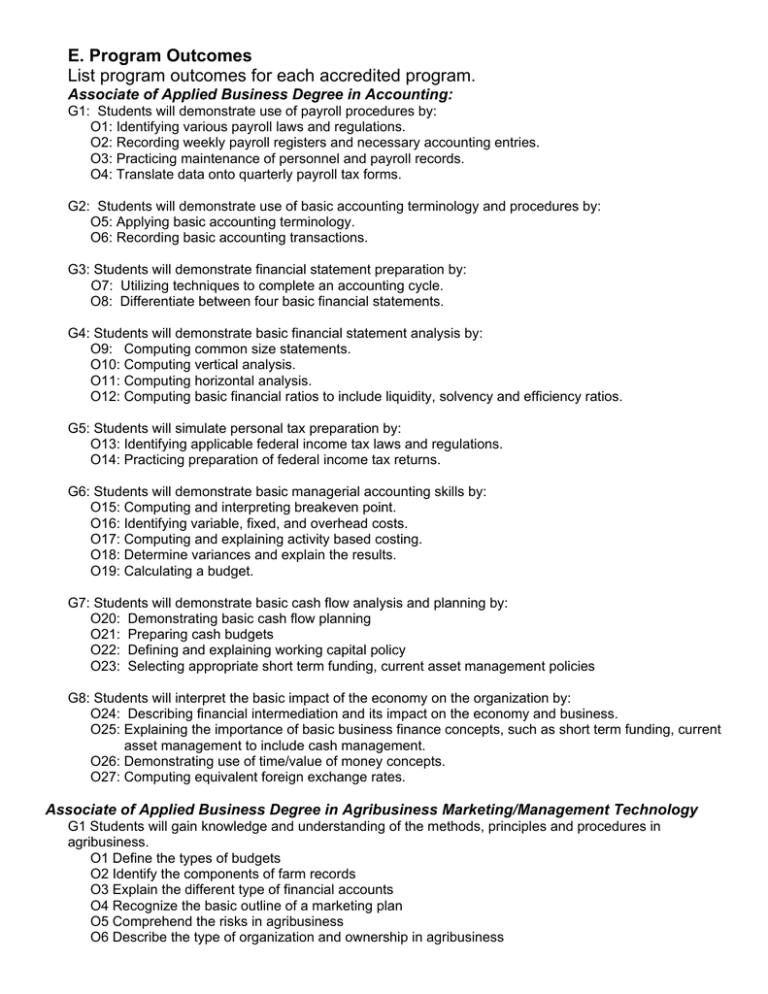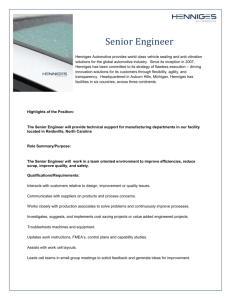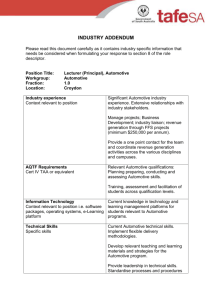E. Program Outcomes List program outcomes for each accredited program.
advertisement

E. Program Outcomes List program outcomes for each accredited program. Associate of Applied Business Degree in Accounting: G1: Students will demonstrate use of payroll procedures by: O1: Identifying various payroll laws and regulations. O2: Recording weekly payroll registers and necessary accounting entries. O3: Practicing maintenance of personnel and payroll records. O4: Translate data onto quarterly payroll tax forms. G2: Students will demonstrate use of basic accounting terminology and procedures by: O5: Applying basic accounting terminology. O6: Recording basic accounting transactions. G3: Students will demonstrate financial statement preparation by: O7: Utilizing techniques to complete an accounting cycle. O8: Differentiate between four basic financial statements. G4: Students will demonstrate basic financial statement analysis by: O9: Computing common size statements. O10: Computing vertical analysis. O11: Computing horizontal analysis. O12: Computing basic financial ratios to include liquidity, solvency and efficiency ratios. G5: Students will simulate personal tax preparation by: O13: Identifying applicable federal income tax laws and regulations. O14: Practicing preparation of federal income tax returns. G6: Students will demonstrate basic managerial accounting skills by: O15: Computing and interpreting breakeven point. O16: Identifying variable, fixed, and overhead costs. O17: Computing and explaining activity based costing. O18: Determine variances and explain the results. O19: Calculating a budget. G7: Students will demonstrate basic cash flow analysis and planning by: O20: Demonstrating basic cash flow planning O21: Preparing cash budgets O22: Defining and explaining working capital policy O23: Selecting appropriate short term funding, current asset management policies G8: Students will interpret the basic impact of the economy on the organization by: O24: Describing financial intermediation and its impact on the economy and business. O25: Explaining the importance of basic business finance concepts, such as short term funding, current asset management to include cash management. O26: Demonstrating use of time/value of money concepts. O27: Computing equivalent foreign exchange rates. Associate of Applied Business Degree in Agribusiness Marketing/Management Technology G1 Students will gain knowledge and understanding of the methods, principles and procedures in agribusiness. O1 Define the types of budgets O2 Identify the components of farm records O3 Explain the different type of financial accounts O4 Recognize the basic outline of a marketing plan O5 Comprehend the risks in agribusiness O6 Describe the type of organization and ownership in agribusiness O7 Recognize basic macro economics in agribusiness O8 Recognize basic micro economics in agribusiness O9 Identify the resources in agribusiness O10 Relate the price of agriculture products to supply of products O11 Interpret the change in demand of agricultural products O12 Explain the foundation of agricultural economics O13 Know the relationship of agricultural policy to agricultural economics O14 Cite the terms used in agricultural marketing O15 Recognize the importance of the futures exchange markets O16 Comprehend the use of basis to determine cash price O17 Interpret the use of hedging in agricultural products O18 Interpret the use of options in agricultural products O19 Choose good management practices O20 Comprehend the characteristics of soils and fertility O21 Recognize management alternatives O22 Explain environmental concerns O23 Examine production practices O24 Understand the use of animal nutrition O25 Examine the main livestock species in the United States Corn Belt Associate of Applied Business Degree in Automotive Management/Automotive Aftermarket Management G1: Students will demonstrate an understanding of automotive parts and service management by: O1: becoming familiar with the principles of parts and service management in the transportation industry O2: developing skills in handling customer service O3: developing skills in preparing service orders, controlling parts sales and inventory G2: Students will demonstrate an understanding of automotive aftermarket industry by: O4: becoming familiar with the principles of the automotive aftermarket industry O5: developing skills in the various automotive aftermarkets such as sales, customer relations, and employability as well as the philosophies of good merchandising O6: enhancing their techniques for organizing a parts and service department to develop customer retention G3: Students will demonstrate an understanding of automotive dealerships by: O7: becoming familiar with the principles of automotive dealership management O8: developing skills in the various automotive dealerships, such as, sales, employee relations, inventory control and employability issues G4: Students will demonstrate an understanding of relationships of the automotive aftermarket and the automotive manufacturing industry by: O9: becoming familiar with the relationships of the automotive aftermarket and the automotive manufacturing industry O10: Understanding the relationships between research, budgeting, and sales G5: Students will demonstrate an understanding of automotive parts and service merchandising by: O11: becoming familiar with the principles of automotive parts and service merchandising O12: developing techniques for effective automotive parts merchandising O13: developing the philosophies of good automotive parts merchandising G6: Students will demonstrate an understanding of automotive aftermarket / wholesaler management by: O14: becoming familiar with the automotive aftermarket / wholesaler management O15: becoming familiar with the principles of Total Customer Relationship management by learning strategies for price structuring G7: Students will demonstrate an understanding of automotive entrepreneurship by: O16: becoming familiar with the concepts of the automotive aftermarket from an entrepreneurial viewpoint G8: Students will demonstrate an understanding of the development of automotive technology by: O17: becoming familiar with the history of the automobile O18: becoming familiar with the history of the ASE O19: associating significant inventors with their contributions to the automotive industry Associate of Applied Business Degree in Business Administration G1: Students will demonstrate an understanding of the planning function of management by: O1: Applying the decision-making process. O2: Discriminating between the types of problems, decisions, biases, errors and decision-making styles that exist in organizations and managers. O3: Recalling the terminology and definitions associated with planning and decision making. O4: Practicing the techniques for decision-making. O5: Applying vision, mission statement, and goal setting to an organization. G2: Students will demonstrate an understanding of the organizing function of management by: O6: Defining an organizational structure based on the degree of work specialization, departmentalization, chain of command, span of control, centralization, and formalization. O7: Recalling the terminology and definitions associated with organizational structure and design. O8: Relating organizational structure variables to human resource management process through recruitment, selection, orientation, training, evaluation, compensation, workforce diversity and career development. O9: Recognizing the types of change within organizations and methods of overcoming resistance to change. G3: Students will demonstrate an understanding of the leading function of management by: O10: Recalling the terminology, definitions and theories associated with leading, leadership, motivation, groups and teams. O11: Expressing how attitudes, personality, perception, and learning can affect leading in organizations. O12: Explaining the theories of leadership and the theories of motivation. O13: Examining current leadership and motivation issues. G4: Students will demonstrate an understanding of the controlling function of management by: O14: Recalling the terminology and definitions associated with the controlling process in organizations. O15: Discussing the tools available for controlling organizational performance. O16: Explaining the control process. G5: Students will demonstrate an understanding of the history of management and managerial trends by: O17: Differentiating between the eras of theories and theorists in management’s history. O18: Expressing the changes in management throughout history. O19: Relating management’s past to current management trends and issues including TQM, Globalization, Ethics, Workforce Diversity, Entrepreneurship, Knowledge Management, MBO and Managing E-Business. G6: Students will demonstrate an understanding of micro and macro environmental factors affecting organizations by: O20: Defining organizational culture. O21: Identifying and interpreting the effects of internal and external task and general macroenvironmental forces on organizations and managers. O22: Relating general management theories and knowledge to small businesses, entrepreneurship, the service sector, and retail establishments. O23: Applying Porter’s Five forces. G7: Students will demonstrate an understanding of the international dimensions affecting US companies by: O24: Relating management theories to global situations. O25: Explaining the importance of international business O26: Identifying different levels of global business O27. Recognizing, defining and explaining the international trade theories (mercantilism, absolute advantage, comparative advantage, factors proportions theory, the international product life cycle, the new trade theory and the national competitive advantage). Associate of Applied Business Degree in Information Technology, Concentration in Computer Forensics CFG1: Students will demonstrate an understanding of the application software used in Computer Forensics by: CFO1: Recognizing the foundational and functional use of Computer Forensics applications CFO2: Demonstrating the ability to select the proper tools to complete various types of forensic investigations. CFG2: Students will demonstrate an understanding of Computer Forensic concepts in relation to Digital Investigations by: CFO3: Demonstrating various techniques used to acquire and analyze digital evidence for forensic investigation CFO4: Demonstrating their ability to identify items that could contain digital evidence. CFO5: Utilizing the technical vocabulary relevant to Computer Forensics study in class discussion CFG3: Students will demonstrate their ability to systematically process of evidence in a Digital Forensic investigation by: CFO6: Creating reports detailing the finding of their investigations CFO7: Developing checklists that will facilitate thorough and efficient investigative practices. CFO8: Utilizing software to extract the most relevant evidence in an efficient way Associate of Applied Business Degree in Information Technology, Concentration in Digital Multimedia Design DG1: Students will demonstrate an understanding of application software used in multimedia by: DO1: Recognizing the foundational and functional applications in multimedia software, DO2: Determining the appropriate application to use based on the medium to obtain the desired result, and DO3: Identifying the methods used in editing graphic images for print and web use. DG2: Students will demonstrate an understanding of all the design concepts in relation to digital multimedia by: DO4: Describing various styles used within digital multimedia, DO5: Identifying the visual limits imposed by media restrictions for print and web use, and DO6: Recognizing the evolution of a proper vocabulary of critical discourse relating to the tools of electronic digital media. DG3: Students will demonstrate an understanding of the design process when applied to creating a digital piece of media by: DO7: Illustrating the knowledge of visual communication styles using formal aesthetic criteria, DO8: Recognizing the technological principles with web media and design, and DO9: Utilizing software layout knowledge to create, design, and manipulate graphic images and video media. Associate of Applied Business Degree in Information Technology, Concentration in Microsoft Networking Technology MG1: Students will demonstrate an understanding of the use of client/server operating systems in a network environment by: MO1: Identifying various Microsoft file systems used in the client/server operating system, MO2: Simulating an installation of the operating system in a workgroup and network environment, and MO3: Practicing the management and troubleshooting of the client/server operating system. MG2: Students will demonstrate an understanding of the tools used to administer the client/server operating system by: MO4: Applying the tools in solving a complex network problem with the client/server operating system, MO5: Simulating exercises that require the use of administration accounts with the client/server operating system, and MO6: Implementing a backup plan and using the plan to recover the client/server operating system from a disaster. MG3: Students will demonstrate an understanding of networking using various protocols by: MO7: Illustrating the knowledge the various networking protocols in the installation of the client/server operating system, MO8: Recognizing that data transfer requires specific protocols within a network environment, and MO9: Demonstrating the use of network security protocols to ensure data integrity. Associate of Applied Business Degree in Information Technology, Concentration in Network Security NG1: Students will demonstrate an understanding of security within a network environment to ensure data integrity by: NO1: Recognizing the many security analysis methods used in data protection, NO2: Determining the need for security within a network environment, and NO3: Identifying the methods used in data backup and recovery in the event of data loss. NG2: Students will demonstrate an understanding of the various network protocols used in the routing of data in a network by: NO4: Describing the network protocols and their use to ensure data integrity in a network environment, NO5: Identifying the methods used to encrypt data for a second layer of protection, and NO6: Explaining the use of the protocols in relation to the topology of a network environment. NG3: Students will demonstrate an understanding of the policy and procedure process in relation to securing data in a network environment by: NO7: Implementing a data security policy that provides a meaningful process in backing up and restoring data within disaster recovery, NO8: Utilizing the data security policy in an ethical manner to ensure data integrity, and NO9: Recognizing the fundamentals within ethical computer forensics to retrieve data securely. Associate of Applied Business Degree in Legal Office Management G1: Students will demonstrate an understanding of Communication skills by: 01. Applying the skills learned in PowerPoint to create a personal presentation 02. Applying the correct formatting of the original letter as well as legal documents and memo composition G2: Students will demonstrate an understanding of Software applications skills by 03. Importing and exporting documents from one application to another G3: Students will demonstrate an understanding of Document formatting by: 04. Applying the skills learned in Keyboarding to format professional legal documents with great efficiency and accuracy. G4: Students will demonstrate an understanding of Group work and interpersonal skills by: 05. 06. 07. Having students from different locations using the discussion forum to complete the projects together. Having students give feedback and suggest some editing features to improve the appearance of the document Having each student prepare part of an assignment and combining those parts to create the final assignment G5: Students will demonstrate an understanding of legal research by: 08. Applying skills learned to conduct proper legal research. Associate of Applied Business Degree in Marketing G1: Students will demonstrate an understanding of the product function of marketing by: O1: Defining and differentiating between the types of products and products and services. O2: Demonstrating the use of branding strategies and new-product development strategies. O3: Recalling the terminology and definitions associated with the product function of marketing. O4: Applying product decisions to cases, simulations, and homework assignments. G2: Students will demonstrate an understanding of the pricing function of marketing by: O5: Defining and calculating the different pricing approaches and strategies. O6: Defining the calculating the new-product pricing strategies and price-adjustment strategies. O7: Recalling the terminology and definitions associated with the pricing function of marketing. O8: Relating and applying pricing decisions to cases, simulations, and homework assignments. G3: Students will demonstrate an understanding of the place or distribution function of marketing by: O9: Recalling the terminology, definitions and theories associated with distributing products and services. O10: Identifying channel design decisions, and channel management decisions. O11: Relating supply change management and logistics decisions to cases, simulations and homework assignments. O12: Expressing how attitudes, personality, perception, and learning can affect leading in organizations. O13: Explaining the nature and importance of marketing channels. G4: Students will demonstrate an understanding of the promotion function of marketing by: O14: Recalling the terminology and definitions associated with the promotion function. O15: Discussing the tools available for creating and implementing an IMC (Integrated Marketing Communications) strategy. O16: Identifying, relating, and interpreting advertising, personal selling, public relations, and sales promotion strategies. O17: Applying promotion decisions to cases, simulations, and homework assignments. G5: Students will demonstrate an understanding of customer groups and segments by: O18: Differentiating between consumer and business market strategies. O19: Defining and applying target marketing, segmenting and positioning strategies to consumer and business markets. O20: Selecting appropriate marketing strategies for various groups of consumers. Associate of Applied Business Degree in Medical Office Management G1: Students will demonstrate an understanding of Communication skills 01. Applying the skills learned in PowerPoint to create a personal presentation 02. Applying the correct formatting of the original letter as well as medical documents and memo composition G2: Students will demonstrate an understanding of Software applications skills by: 03. Importing and exporting documents from one application to another G3: Students will demonstrate an understanding of Document formatting by: 04. Applying the proper format to the different styles of letters 05. Applying the proper format to the different styles of reports 06. Applying the proper format to the different styles of tables 07. Applying proper formatting to documents when transcribing messages G4: Students will demonstrate an understanding of Group work and interpersonal skills by: 08. Having students from different locations using the discussion forum to complete the projects together. 09. Having students give feedback and suggest some editing features to improve the appearance of the document 010. Having each student prepare part of an assignment and combining those parts to create the final assignment G5: Students will demonstrate an understanding of HIPPA law by 011. Applying these laws to different situations. Associate of Applied Business Degree in Office Management G1: Students will demonstrate an understanding of oral and written communications skills by: 01: reviewing and applying proper grammar when creating documents 02: reviewing and applying proper punctuation when creating documents 03: presenting assignments verbally to the class 04: by creating and sending e-mail messages to others within a company G2: Students will demonstrate an understanding of software application skills, especially the ability to integrate software by: 05: importing and exporting documents from one application to another 06: comparing applications and using the steps in one application to complete the same function in another application 07: applying the skills learned in PowerPoint to create a personal presentation 08: applying the skills learned to create advanced documents (flyers; brochures, newsletters, etc.) G3: Students will demonstrate an understanding of document formatting skills by: 09: applying the proper format to the different styles of letters 010: applying the proper format to the different styles of reports 011: applying the proper format to the different styles of tables 012: applying proper formatting to documents when transcribing messages G4: Students will demonstrate an understanding of group work and interpersonal skills by: 013: having students from different locations using the discussion forum to complete the projects together. 014: having students give feedback and suggest some editing features to improve the appearance of the document 015: having each student prepare part of an assignment and combining those parts to create the final assignment (ex. Each student writes an article. The articles are then combines to create a newsletter) Associate of Applied Business Degree in Word Processing / Administrative Support G1: Students will demonstrate an understanding of oral and written communications skills by: 01: reviewing and applying proper grammar when creating documents 02: reviewing and applying proper punctuation when creating documents 03: presenting assignments verbally to the class 04: by creating and sending e-mail messages to others within a company G2: Students will demonstrate an understanding of software application skills, especially the ability to integrate software by: 05: importing and exporting documents from one application to another 06: comparing applications and using the steps in one application to complete the same function in another application 07: applying the skills learned in PowerPoint to create a personal presentation 08: applying the skills learned to create advanced documents (flyers; brochures, newsletters, etc.) G3: Students will demonstrate an understanding of document formatting skills by: 09: applying the proper format to the different styles of letters 010: applying the proper format to the different styles of reports 011: applying the proper format to the different styles of tables 012: applying proper formatting to documents when transcribing messages G4: Students will demonstrate an understanding of group work and interpersonal skills by: 013: having students from different locations using the discussion forum to complete the projects together. 014: having students give feedback and suggest some editing features to improve the appearance of the document 015: having each student prepare part of an assignment and combining those parts to create the final assignment (ex. Each student writes an article. The articles are then combines to create a newsletter)






